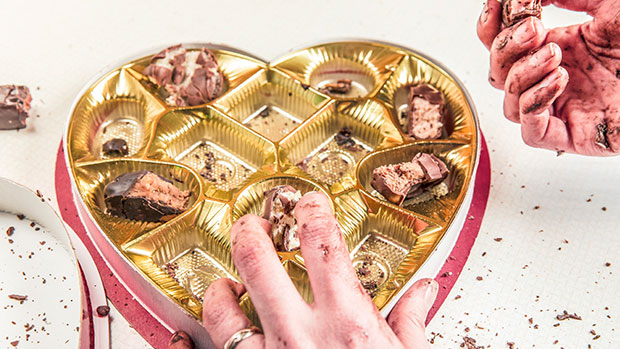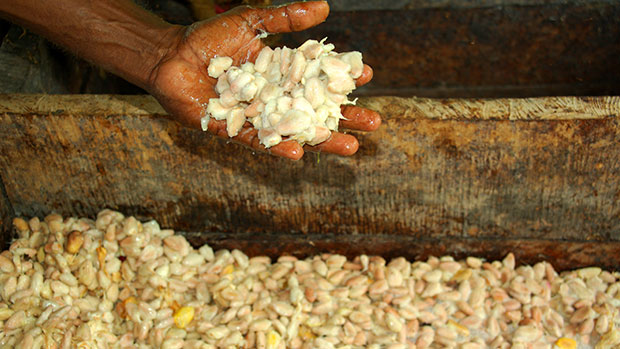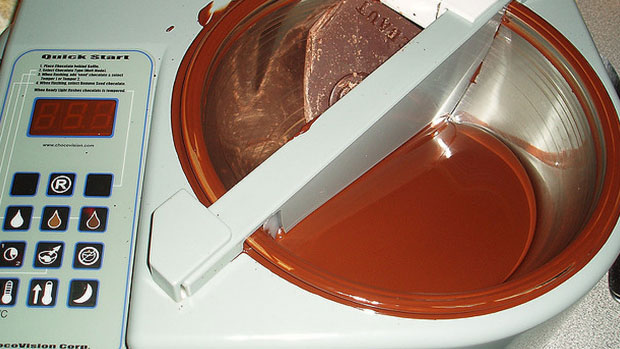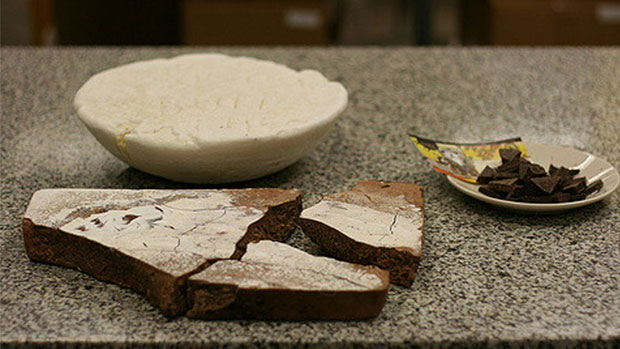Chocolate: the sweet taste of ... chemistry?
Expert reviewers
Essentials
- Over 1500 flavour components have been identified in chocolate, making it one of the most complex chemical mixtures known
- Chemicals in chocolate can affect your brain, potentially making you feel happier and more alert
- In moderation, chocolate may be beneficial to your health
- The love of chocolate is global—more than $100 billion was spent on chocolate in 2015
- Australians on average spent nearly $100 per person on chocolate in 2015
I’ll admit it. I’m a huge chocoholic. For me, I can’t resist a piece (or three) of dark chocolate, though I’ll settle for the milk varieties if I have to. In times of desperation, I’ve even been known to reach for compound chocolate, and that’s saying something. But why does chocolate have such a strong allure? Why are so many of us powerless to resist when we see it? The answer may surprise you—it’s all because of chemistry.

Chocolate basics
We know it’s delicious, but what actually is chocolate? In Australia, chocolate is defined as ‘a confectionery product characterised by the presence of cocoa bean derivatives,’ namely cocoa liquor, cocoa butter and cocoa solids. However, the percentage of these components may be very different between two products both sold as chocolate. Chocolate can be a solid, a liquid or a paste, and, along with the cocoa solids and cocoa butter, generally contains some variety of added sweetener, such as sugar or condensed milk, to offset the bitter taste of cocoa. Modern commercial varieties of chocolate can also include added flavours, preservatives, milk solids and modifiers.
Cacao (also known as cocoa) comes from the Cacao Tree (Theobroma Cacao), which grows in warm, tropical climates generally within 20 degrees of the equator. Each Cacao pod contains around 30-45 seeds (often called beans), and it is the nibs of these seeds—the cotyledons—from which chocolate is made.
From bean to bar
If you thought choosing which chocolate treat to eat was complex, take a moment to appreciate the intricate process of first turning it from bean to bar. It’s labour intensive and involves many steps—and chemistry is involved in all of them.
Chocolate doesn’t grow on trees, but the cacao seeds—chocolate’s primary ingredient—does. But if you’re imagining chocolate-flavoured seeds, you’re in for a shock. When first removed from the pod, the seeds taste, well, pretty awful. They’re bitter and rough and not at all chocolatey. To obtain the flavour we know and love, several chemical transformations must first occur.
Fermentation and curing
Fermentation must begin within 24-48 hours of pods being opened, and generally lasts 5-7 days. The beans are piled in heaps or placed in special boxes.
Microorganisms quickly get to work removing the pulp from the beans. Yeasts grow on the pulp, converting the sugars in it to ethanol. As bacteria move in they oxidise the ethanol to acetic acid and then to carbon dioxide (CO2) and water. This produces heat and raises the temperature. The pulp breaks down and both lactic acid and acetic acid are produced. The acetic acid eventually kills the bean, which results in its cell walls breaking down and the mixing of several previously separated substances.

This process results in changes within the bean, known as the curing process. It involves enzyme activity, oxidation and the breakdown of proteins into amino acids.
This stage develops important flavour precursors, which are the beginnings of the unique chocolate taste and aroma we know. It also browns the beans.
Roasting and winnowing
After fermentation, the beans are cleaned, sorted, graded and then roasted.
During roasting the vinegar smell produced by fermentation is removed. The bean shells become brittle and the colour of the beans darken. The process converts the flavour precursors within the bean into compounds such as aldehydes, esters, lactones, and pyrazine, which give chocolate its aroma and flavour.
A winnowing machine removes the bean shells and leaves just the cacao nib. The nibs are then ground and liquefied into a cocoa liquor. Heavy-duty presses can further process and separate the liquor into either fat-rich cocoa butter or cocoa solids (that are ground to make cocoa powder).
Blending
To make the different varieties of chocolate cocoa butter is added back into pure liquor. The amount of each is determined by the kind of chocolate being manufactured. Other ingredients such as sugar, vanilla, milk solids, additional fats (found in cheaper chocolates) and other flavours are also added during this step.
Refining
Prior to refining (also known as conching), the blended chocolate can still be rough and a bit gritty. Conching slowly mixes the ingredients together under heat while at the same time continuously grinding them to create a smooth finish. This breaks down the sugar and cocoa into particles too small for the tongue to detect. The longer the chocolate stays in the conching machine, the smoother the end product. Cheaper chocolate may be conched for around 4 hours, while the more expensive varieties can be anywhere up to 72 hours.
Tempering
Tempering—the process of varying the temperature at which chocolate is cooled—is the essential step in producing many of chocolate’s most-desired qualities. Its smooth shine and rich texture, its ‘snap’ and the way it melts in your mouth are all the thanks to the formation of just the right type of chocolate crystal, which is created during the tempering process.

Cocoa butter contains several different fatty acids, primarily oleic acid, stearic acid and palmitic acid. In melted chocolate, the fatty crystals are separate. The aim of tempering is to bring these disparate fatty acids back into one single, stable form (made more difficult by the fact that each of the fatty acids solidifies at a different temperature).
There are six known forms of chocolate crystal (polymorph), each producing different properties in the finished product (soft/firm/crumbly etc.) Only one type of chocolate crystal—type V—is considered ‘perfect’.
| Polymorph | Melting temperature | Properties |
|---|---|---|
|
I |
17℃ |
Soft, crumbly, melts easily, noticeable blooming |
|
II |
21℃ |
Soft, crumbly, melts easily, noticeable blooming |
|
III |
26℃ |
Firm, average snap, melts easily, some blooming |
|
IV |
28℃ |
Firm, average snap, melts easily, some blooming |
| V | 34℃ | Glossy, smooth texture, firm, melts in the mouth |
|
VI |
36 |
Hard, slow melt, some blooming |
While achieving type V is difficult, this is the polymorph that most chocolate makers aim for.
Dutching
Dutching is the chemical process of alkalising cocoa solids to make them less bitter and less acidic, and therefore easier to work with in cooking or as a powder. It makes the cocoa appear even darker, and destroys some of the extra flavonoids found in truly dark chocolate.
Packaging and storage
Believe it or not, the packaging and wrapping of your chocolate is not just for decoration. It’s there to protect your chocolate from light, the elements and insects.
Have you ever eagerly opened up your favourite chocolate bar only to notice an unsightly white or grey coating over it? It’s a chocolate-lover’s nightmare. This is known as chocolate bloom, but unlike algal bloom there are no microbes involved. There are two types of chocolate bloom:
Sugar bloom occurs when moisture condenses on the chocolate, especially when chocolate is placed in the fridge. Sugars within the chocolate absorb the moisture and dissolve. When the excess moisture evaporates, the sugar reforms into larger crystals, resulting in the white, dusty, dry-feeling layer you see.
Fat bloom occurs when the small globules of cocoa butter within your chocolate have coagulated into larger ones, resulting in a greasy, grey surface covering. Causes include poor storage (too warm), incorrect tempering or cooling during production, mixing incompatible fats with cocoa butter during production and damage through poor handling.

While chocolate that has bloomed is safe to eat and tastes the same, chocolate aficionados will decry its unpleasant appearance and rough texture. But all is not lost. Chocolate that has bloomed can be redeemed—with time and a bit of work. Melt the compromised chocolate down, stir it well and then reset in moulds. This will recombine the sugar and fats into the chocolate mix…just be sure to store it properly once you’ve finished. However, if you can’t wait for your chocolate fix, just shut your eyes as you munch away.
So, now you have a basic understanding of how chocolate is made, and why following the above steps is so important. Without them, and the chemical reactions they produce, there would be no chocolate.
Can chocolate make me happy?
There is a reason chocolate is variously called the ‘love drug’, the ‘happiness drug’ and the ‘pleasure drug’, and it’s not to do with marketing. Chocolate contains numerous ingredients, chemicals and compounds that have been shown to affect the brain and body in a myriad of ways, most of them pleasurable and positive.
Let’s take a look at some of them:
Theobromine
Theobromine (previously known as xantheose) is an alkaloid, belonging to the everyday chemistry of the plant world. It’s also found in varying amounts in tea, coffee, and the kola nut, though chocolate is the richest known source. Interestingly, there is no bromine in theobromine—the name comes from the cacoa tree—Theobroma. The ‘ine’ on the end is due to chemistry’s naming convention and can be found in many alkaloids such as caffeine, nicotine and morphine.
Theobromine is chemically only one methyl group different from caffeine and has many of the same stimulant effects on the human brain when given in equal doses. This contributes to that well-known lift you get from eating chocolate.
Just remember, while the human brain may enjoy a small dose, don’t give it to Fido—both theobromine and caffeine are potentially lethal to dogs which shows just how biologically active these compounds really are.
Anandamide
Anandamide—an endogenous cannabinoid—is produced naturally in the brain but small quantities are also found in chocolate. It helps to stimulate and open synapses in the brain, which allows feel good waves to transmit more readily. While anandamide affects the same structures of the brain as THC (the active ingredient in cannabis), you would need to eat kilos of chocolate to have a similar effect.

Phenylethylamine (PEA)
Feeling lovey-dovey? Perhaps a bit giddy, excited or aroused? That may well be the effects of phenylethylamine, a chemical which stimulates the brain’s pleasure centres and which is released when we fall in love. And the food that contains the highest concentrations of phenylethylamine? Yep—chocolate. No wonder it’s so popular on Valentine’s Day. But don’t get too excited—most of the phenylethylamine derived from chocolate is metabolised before it reaches our central nervous system, making it unlikely to have any significant aphrodisiac effects on the brain.
Sugar
Sugar is a simple carbohydrate that, once consumed, is quickly split into glucose and fructose. The glucose provides a burst of energy, while also activating the reward centre of the brain. Most chocolate bars contain a fair whack of sugar—dark chocolate generally has around 30 per cent and milk chocolate upwards of 50-60 per cent. When these high levels of sugar are combined with chocolate’s other enticing chemical and physical properties, it’s no wonder our bodies and brains crave it.
While the small amounts of each individual chemical in chocolate may not have profound effects on the brain, the combination of them all packaged together in a handy bar, which looks and tastes great and feels like a bit of an indulgence is a winning combination to produce happy feelings in the eater.
Chocolate as a health food?
It seems that every few months reports in the media joyfully proclaim that yet another study has ‘proven’ chocolate’s health prowess.
Cocoa solids and the chocolates that contain them—particularly the dark varieties—have long been espoused as a rich natual source of antioxidants. Cocoa solids contain a range of flavonoids and phenols such as epicatechin and gallic acid—antioxidant substances that work to reduce cellular and arterial damage and even ageing. However, many of these are lost in the chocolate-making process. So technically the unprocessed cocoa seed is good for you, the finished chocolate, not quite so much. Yet despite chocolate having lower levels of flavonoids, some of the antioxidant benefits may remain. By contrast white chocolate, which contains no cocoa solids at all, consequently contains almost no antioxidant flavonoids.
Despite the limitations of cenventional chocolate and its processing, researchers have noted that higher levels of chocolate consumption is associated with a reduced risk of cardiovascualr disease, possibly through effects on blood vessel function, and better memory retention. A 2012 review of several studies also found the consumption of cocoa products may help to lower blood pressure slightly.

But before you get too excited and replace your vitamins for chocolate bars, it’s worth noting that there are several weaknesses with many of these studies.
Firstly, most of them are observational, meaning participants answered questions about their health and chocolate consumption, and their responses were used by researchers to draw statistical connections. While we can obtain some insights from this information, they do not prove cause and effect. There may be other reasons why the same people who like to eat chocolate also have less heart-attacks, including socioeconomic, mood, lifestyle, psychological or other factors.
Other studies were of short duration, with no follow up studies conducted, or consisted of participants consuming high doses of chocolate, many times a day, like a drug. Small effects in a research setting cannot be assumed to have long-term effects in the real world.
Moreover, the ‘health’ benefits of chocolate need to be weighed against its potentially unhealthy aspects—namely its high calorific intake thanks to its percentage of fat and sugar, and the fact that it's easy to eat more than the recommended daily amount.
As with most things, it’s moderation that’s the key. A small piece of dark chocolate each day, when eaten as part of a balanced diet, won't greatly improve your health, but it won't hurt either. And it might just make you feel a little bit better.
So thank you, chemistry
From the moment the cacao pods are picked to the time you place that first delicious square of chocolate on your tongue, chemistry is playing a part. It influences the taste, colour, texture and aroma of chocolate. And, once ingested, those chemicals continue to work their magic as they subtly influence your brain and body. So the next time you reach for a treat, remember to thank not only the skilled chocolatiers but also the incredible science of chemistry for helping to create the delicious wonder that is chocolate.





